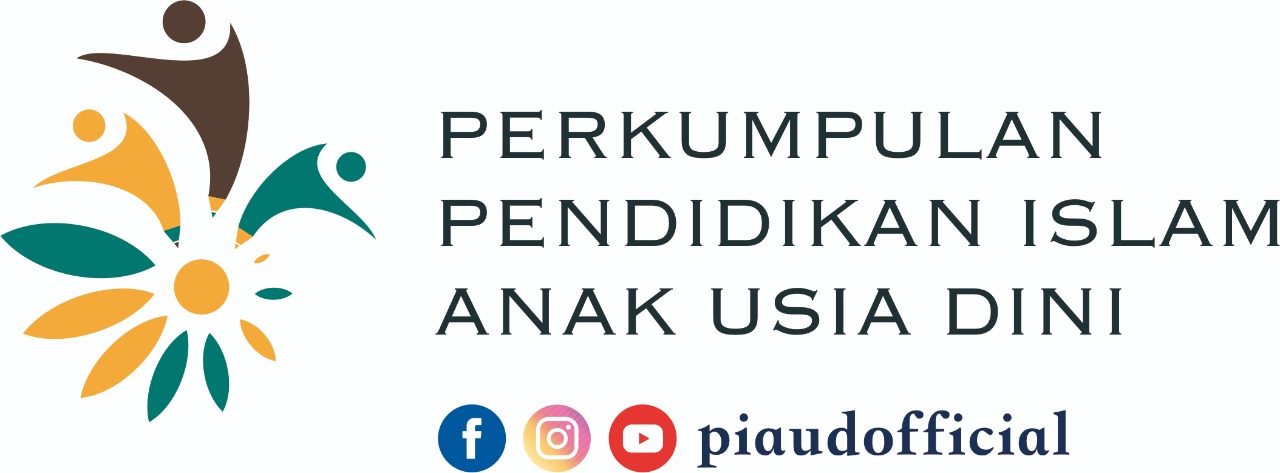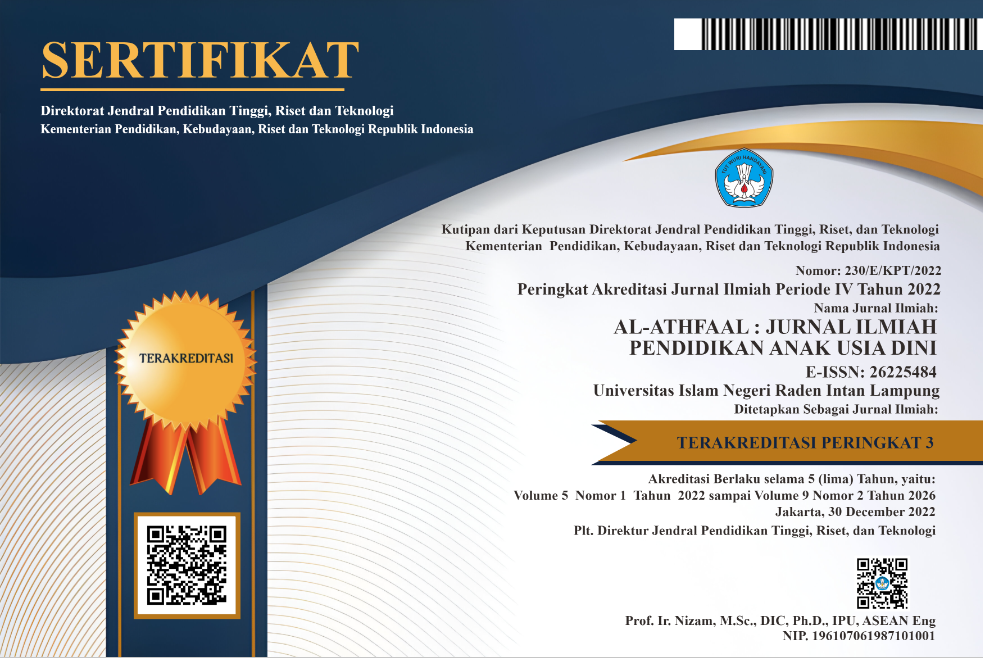Application of TEACCH method to sharpen life skills in children with autism.
Abstract
Background : The prevalence of autism in Indonesia has risen significantly in recent years, requiring targeted interventions to address developmental challenges. Special education institutions like TKLB River Kids play a crucial role in equipping autistic children with essential life skills to enhance their independence and quality of life. The TEACCH (Treatment and Education of Autistic and Associated Communication Handicapped Children) method has been widely recognized for its structured approach tailored to the unique needs of autistic individuals. This study examines the implementation of the TEACCH method at TKLB River Kids to explore its impact on developing life skills among autistic children.
Aim : The study aims to analyze the application of the TEACCH method in honing life skills among autistic children at TKLB River Kids, identifying the influencing factors and the outcomes of this intervention.
Method : This qualitative study employed a case study design to deeply explore the implementation of the TEACCH method. Data collection involved a one-month observation, interviews with three teachers and one therapist, and documentation analysis at TKLB River Kids. Triangulation techniques were used to validate the data, and Miles and Huberman's interactive model was applied for analysis.
Results : The findings reveal that the TEACCH method, utilizing visual schedules, independent work systems, and structured task organization, significantly improved life skills such as self-care, communication, motor development, and social interaction. Internal factors like children’s motivation and cognitive abilities, as well as external factors including parental support and the availability of visual aids, influenced the program’s success. Improvements in emotional regulation, task completion, and independence were observed, with parents and educators reporting reduced stress and enhanced family dynamics.
Conclusion : The structured implementation of the TEACCH method at TKLB River Kids has effectively fostered independence and life skills development in autistic children. The collaborative approach involving schools and families highlights the potential for broader application in special education settings, offering a sustainable model for enhancing the well-being of children with Autism Spectrum Disorder.
Keywords
Full Text:
PDFReferences
A, S., & Harsiwi, T. (n.d.). Peran lembaga pendidikan dalam pengembangan anak autis: Studi kasus di SLB Jakarta. Jurnal Pendidikan Khusus, 15(1), 1–15
Abdullah, M. (n.d.). Tantangan dan solusi dalam penanganan anak autis di Indonesia. Jurnal Kesehatan Masyarakat Indonesia, 8(1), 45–58
Anderson, D. (2012). A balanced approach to excellence: Life-skill intervention and elite performance. Reflective Practice, 13(4), 609–620. https://doi.org/10.1080/14623943.2012.670625
Arthur-Kelly, M., Sigafoos, J., Green, V., Mathisen, B., & Arthur-Kelly, R. (2009). Issues in the use of visual supports to promote communication in individuals with autism spectrum disorder. Disability and Rehabilitation, 31(18), 1474–1486. https://doi.org/10.1080/09638280802590629
Bolat, Y., & Korkmaz, C. (2021). Social values and life skills as predictors of organizational culture: A study on teachers. Sage Open, 11(2). https://doi.org/10.1177/21582440211023179
Boyce, L. A., Zaccaro, S. J., & Wisecarver, M. Z. (2010). Propensity for self-development of leadership attributes: Understanding, predicting, and supporting performance of leader self-development. The Leadership Quarterly, 21(1), 159–178. https://doi.org/10.1016/j.leaqua.2009.10.012
Bronfenbrenner, U. (1979). The ecology of human development: Experiments by nature and design. Harvard University Press https://doi.org/10.4159/9780674028845
Buchert, L. (2014). Learning needs and life skills for youth: An introduction. International Review of Education, 60(2), 163–176. https://doi.org/10.1007/s11159-014-9431-3
Camiré, M. (2023). The two continua model for life skills teaching. Sport, Education and Society, 28(8), 915–928. https://doi.org/10.1080/13573322.2022.2073438
Cerniglia, L., Zoratto, F., Cimino, S., Laviola, G., Ammaniti, M., & Adriani, W. (2017). Internet addiction in adolescence: Neurobiological, psychosocial, and clinical issues. Neuroscience & Biobehavioral Reviews, 76, 174–184. https://doi.org/10.1016/j.neubiorev.2016.12.024
Chow, C., & Tiwari, A. (2014). Experience of family caregivers of community-dwelling stroke survivors and risk of elder abuse: A qualitative study. The Journal of Adult Protection, 16(5), 276–293. https://doi.org/10.1108/JAP-03-2014-0007
Dacholfany, M. I., Rahmi, H., & Tira, D. S. (2023). Evaluation of the disability-friendly education management model in elementary schools. Jurnal Kajian Pendidikan dan Psikologi, 1(2), 92–101. https://doi.org/10.61397/jkpp.v1i2.54
Dillenbourg, P. (1999). Collaborative learning: Cognitive and computational approaches. Pergamon
Dubois, J., & Trabelsi, M. (2007). Education in pre‐ and post‐conflict contexts: Relating capability and life‐skills approaches. International Journal of Social Economics, 34(1/2), 53–65. https://doi.org/10.1108/03068290710723363
Fante, C., De Luca Picione, R., Dioni, B., Manari, T., Raffin, C., Capelli, F., Franceschini, C., Lenzo, V., & Musetti, A. (2024). Parental quality of life and impact of multidisciplinary intervention for children with autism spectrum disorders: A qualitative study. Journal of Autism and Developmental Disorders. https://doi.org/10.1007/s10803-023-06225-x
Farahmand, M. A., Adibsereshki, N., Poshtmashhadi, M., & Bidhendi, R. (2024). Influence of group active play on social skill and emotion regulation in children with hearing impairment. Practice in Clinical Psychology, 12(3), 275–284. https://doi.org/10.32598/jpcp.12.3.963.1
Gould, D., & Carson, S. (2008). Life skills development through sport: Current status and future directions. International Review of Sport and Exercise Psychology, 1(1), 58–78. https://doi.org/10.1080/17509840701834573
Harrop, C., Jones, D. R., Sasson, N. J., Zheng, S., Nowell, S. W., & Parish‐Morris, J. (2020). Social and object attention is influenced by biological sex and toy gender‐congruence in children with and without autism. Autism Research, 13(5), 763–776. https://doi.org/10.1002/aur.2245
Hennekam, S. (2015). Career success of older workers: The influence of social skills and continuous learning ability. Journal of Management Development, 34(9), 1113–1133. https://doi.org/10.1108/JMD-05-2014-0047
Hidayat, R., Sulistyo, A., & Permadi, F. (n.d.). Evaluasi program pendidikan inklusif pada sekolah luar biasa. Jurnal Pendidikan Indonesia, 12(3), 78–92
Huber, H. B., & Carter, E. W. (2016). Data-driven individualization in peer-mediated interventions for students with ASD: A literature review. Review Journal of Autism and Developmental Disorders, 3(3), 239–253. https://doi.org/10.1007/s40489-016-0079-8
Kasari, C., Sturm, A., & Shih, W. (2018). SMARTer approach to personalizing intervention for children with autism spectrum disorder. Journal of Speech, Language, and Hearing Research, 61(11), 2629–2640. https://doi.org/10.1044/2018_JSLHR-L-RSAUT-18-0029
Kirchhoff, E., & Keller, R. (2021). Age-specific life skills education in school: A systematic review. Frontiers in Education, 6. https://doi.org/10.3389/feduc.2021.660878
Kusuma, A., & Wijaya, S. (n.d.). Efektivitas pendidikan khusus dalam meningkatkan kemampuan adaptif anak autis. Jurnal Penelitian Pendidikan, 7(4), 201–215
Kusuma, R., Hartono, S., & Pratama, I. (n.d.). Analisis kebijakan pelayanan kesehatan untuk anak berkebutuhan khusus di Indonesia. Jurnal Kebijakan Kesehatan Indonesia, 12(2), 78–92
Mahoney, G., & Wheeden, C. A. (1997). Parent-child interaction: The foundation for family-centered early intervention practice. Topics in Early Childhood Special Education, 17(2), 165–184. https://doi.org/10.1177/027112149701700204
Mallory, D. B. (2024). "Capable of much more": The effects of vocational training on caregiver expectations for neurodivergent dependents in Thailand. PLOS ONE, 19(7), e0306141. https://doi.org/10.1371/journal.pone.0306141
McCollum, B. (1999). Leadership development and self‐development: An empirical study. Career Development International, 4(3), 149–154. https://doi.org/10.1108/13620439910262813
Nawasita, K. D., Timan, A., & Sultoni, S. (2023). The strategic management of literacy learning in inclusive primary school in Malang. Journal of Research in Instructional, 3(2), 382–394. https://doi.org/10.30862/jri.v3i2.289
Ng, M. Y., & Weisz, J. R. (2016). Annual research review: Building a science of personalized intervention for youth mental health. Journal of Child Psychology and Psychiatry, 57(3), 216–236. https://doi.org/10.1111/jcpp.12470
Nugraha, P., & Putri, L. (n.d.). Analisis kebutuhan layanan pendidikan bagi anak berkebutuhan khusus. Jurnal Studi Pendidikan, 6(2), 88–102
Nugroho, A. (n.d.). Evaluasi program pendampingan anak autis di sekolah inklusi. Jurnal Pendidikan Khusus, 9(3), 112–125
Panerai, S., Zingale, M., Trubia, G., Finocchiaro, M., Zuccarello, R., Ferri, R., & Elia, M. (2009). Special education versus inclusive education: The role of the TEACCH program. Journal of Autism and Developmental Disorders, 39(6), 874–882. https://doi.org/10.1007/s10803-009-0696-5
Prasertcharoensuk, T., Somprach, K., & Ngang, T. K. (2015). Influence of teacher competency factors and students’ life skills on learning achievement. Procedia - Social and Behavioral Sciences, 186, 566–572. https://doi.org/10.1016/j.sbspro.2015.04.021
Pratiwi, D., & Hidayat, R. (n.d.). Peran stakeholder dalam peningkatan layanan kesehatan anak autis. Jurnal Manajemen Kesehatan, 7(1), 23–35
Pratiwi, S., Handayani, R., & Santoso, B. (n.d.). Model pembelajaran adaptif untuk anak autis: Kajian empiris. Jurnal Pendidikan Khusus, 10(2), 67–82
Purnomo, H. (n.d.). Strategi pengembangan kemandirian siswa autis di sekolah luar biasa. Jurnal Pendidikan Inklusi, 5(3), 145–160
Raeff, C. (1997). Individuals in relationships: Cultural values, children’s social interactions, and the development of an American individualistic self. Developmental Review, 17(3), 205–238. https://doi.org/10.1006/drev.1997.0427
Rahman, A., Sulistyowati, E., & Putra, D. (n.d.). Tren peningkatan kasus autisme di Indonesia: Analisis data 2018–2023. Indonesian Journal of Public Health, 15(2), 67–80
Rahmawati, S., Gunawan, A., & Prasetyo, B. (n.d.). Hambatan akses layanan kesehatan bagi anak autis di Indonesia. Jurnal Kesehatan Indonesia, 11(1), 34–46
Reschly, A. L., & Christenson, S. L. (2012). Moving from “context matters” to engaged partnerships with families. Journal of Educational and Psychological Consultation, 22(1–2), 62–78. https://doi.org/10.1080/10474412.2011.649650
Safitri, M., & Rahman, B. (n.d.). Metode pengembangan keterampilan sosial anak autis. Jurnal Psikologi dan Pendidikan, 6(3), 178–193
Saini, I. K. (2016). Strengthening life skills through emotional intelligence education. Educational Quest - An International Journal of Education and Applied Social Sciences, 7(1), 5. https://doi.org/10.5958/2230-7311.2016.00011.8
Santoso, B. (n.d.). Perkembangan kasus autisme di Indonesia: Studi epidemiologi. Jurnal Epidemiologi Indonesia, 6(1), 12–24
Sarkadi, A., Kristiansson, R., Oberklaid, F., & Bremberg, S. (2008). Fathers’ involvement and children’s developmental outcomes: A systematic review of longitudinal studies. Acta Paediatrica, 97(2), 153–158. https://doi.org/10.1111/j.1651-2227.2007.00572.x
Schopler, E., Mesibov, G. B., Shigley, R. H., & Bashford, A. (1984). Helping autistic children through their parents. In The effects of autism on the family (pp. 65–81). Springer US. https://doi.org/10.1007/978-1-4899-2293-9_4
Schuck, R. K., Tagavi, D. M., Baiden, K. M. P., Dwyer, P., Williams, Z. J., Osuna, A., Ferguson, E. F., Jimenez Muñoz, M., Poyser, S. K., Johnson, J. F., & Vernon, T. W. (2022). Neurodiversity and autism intervention: Reconciling perspectives through a naturalistic developmental behavioral intervention framework. Journal of Autism and Developmental Disorders, 52(10), 4625–4645. https://doi.org/10.1007/s10803-021-05316-x
Singh, S., & Agarwal, S. (2024). Empowering individuals for a sustainable tomorrow: Role of life skills development. Journal of Ecophysiology and Occupational Health, 211–219. https://doi.org/10.18311/jeoh/2024/35800
Stahmer, A. C., Suhrheinrich, J., Yu, Y., Melgarejo, M., Schetter, P., & Young, G. A. (2023). Implementation readiness for evidence-based autism practices in school systems. Implementation Research and Practice, 4. https://doi.org/10.1177/26334895231199465
Stahmer, A. C., Vejnoska, S., Iadarola, S., Straiton, D., Segovia, F. R., Luelmo, P., Morgan, E. H., Lee, H. S., Javed, A., Bronstein, B., Hochheimer, S., Cho, E., Aranbarri, A., Mandell, D., Hassrick, E. M., Smith, T., & Kasari, C. (2019). Caregiver voices: Cross-cultural input on improving access to autism services. Journal of Racial and Ethnic Health Disparities, 6(4), 752–773. https://doi.org/10.1007/s40615-019-00575-y
Steinbrenner, J. R., Odom, S. L., Hall, L. J., & Hume, K. (2020). Moving beyond fidelity: Assessing implementation of a comprehensive treatment program for adolescents with autism spectrum disorder. Exceptional Children, 86(2), 137–154. https://doi.org/10.1177/0014402919855321
Sutanto, P., & Permadi, A. (n.d.). Analisis kualitas layanan pendidikan khusus bagi anak autis. Jurnal Pendidikan Indonesia, 10(4), 156–169
Sutrisno, A., Widodo, R., & Pratama, H. (n.d.). Evaluasi program life skills untuk siswa berkebutuhan khusus. Jurnal Pendidikan dan Pembelajaran, 13(1), 23–38
Tawa, A. B., Bafadal, I., Ulfatin, N., & Burhanuddin, B. (2024). Learning for children with special needs: The effect of visionary leadership and organizational commitment on teachers’ performance. European Journal of Educational Research, 13(1), 131–144. https://doi.org/10.12973/eu-jer.13.1.131
Virues-Ortega, J., Julio, F. M., & Pastor-Barriuso, R. (2013). The TEACCH program for children and adults with autism: A meta-analysis of intervention studies. Clinical Psychology Review, 33(8), 940–953. https://doi.org/10.1016/j.cpr.2013.07.005
Vygotsky, L. S. (1978). Mind in society: The development of higher psychological processes. Harvard University Press
Wheeler, J. V. (2008). The impact of social environments on emotional, social, and cognitive competency development. Journal of Management Development, 27(1), 129–145. https://doi.org/10.1108/02621710810840802
WHO. (2005). Skills for health. Nursing Management, 12(7), 39–39. https://doi.org/10.7748/nm.12.7.39.s23
Widodo, H., & Sari, R. (n.d.). Manajemen program pendidikan khusus di SLB. Jurnal Manajemen Pendidikan, 9(1), 90–105
Wijaya, H., & Putri, L. (n.d.). Prevalensi autisme pada anak usia sekolah di Indonesia. Jurnal Kedokteran dan Kesehatan, 14(3), 89–102
Wulandari, E., & Permana, S. (n.d.). Pengembangan kemandirian siswa autis melalui program terstruktur. Jurnal Penelitian Pendidikan Khusus, 4(2), 112–127
Yang, C., & Bradford Brown, B. (2016). Online self-presentation on Facebook and self development during the college transition. Journal of Youth and Adolescence, 45(2), 402–416. https://doi.org/10.1007/s10964-015-0385-y
Zaman, S., Dar, H., & Arshad, S. S. (2023). Assessing students’ life skills and their sources of learning. Review of Education, Administration & Law, 6(2), 167–179. https://doi.org/10.47067/real.v6i2.323
Zeng, H., Liu, S., Huang, R., Zhou, Y., Tang, J., Xie, J., Chen, P., & Yang, B. X. (2021). Effect of the TEACCH program on the rehabilitation of preschool children with autistic spectrum disorder: A randomized controlled trial. Journal of Psychiatric Research, 138, 420–427. https://doi.org/10.1016/j.jpsychires.2021.04.025
DOI: http://dx.doi.org/10.24042/al-athfaal.v7i2.24343
Refbacks
- There are currently no refbacks.
Copyright (c) 2024 Al-Athfaal: Jurnal Ilmiah Pendidikan Anak Usia Dini
License URL: https://creativecommons.org/licenses/by-sa/4.0
 Semua publikasi Al-Athfaal: Jurnal Ilmiah Pendidikan Anak Usia Dini [p-ISSN: 2622-5484, e-ISSN: 2622-5182] dilisensikan di bawah Lisensi Internasional Creative Commons Atribusi-BerbagiSerupa 4.0.
Semua publikasi Al-Athfaal: Jurnal Ilmiah Pendidikan Anak Usia Dini [p-ISSN: 2622-5484, e-ISSN: 2622-5182] dilisensikan di bawah Lisensi Internasional Creative Commons Atribusi-BerbagiSerupa 4.0.











